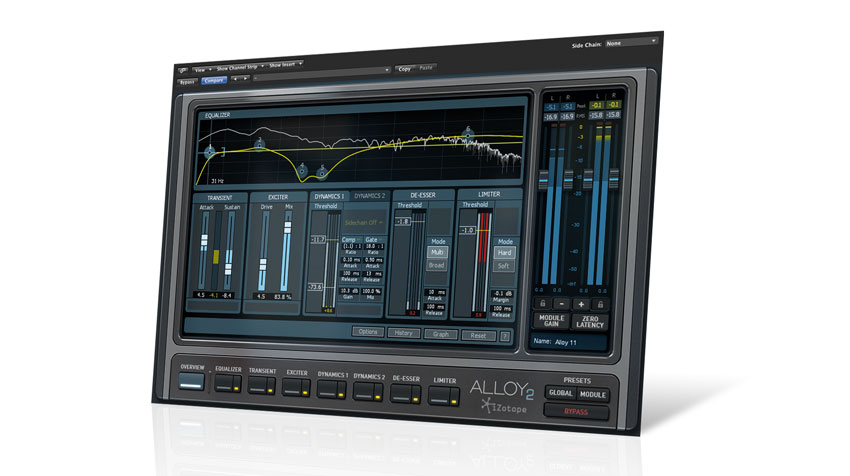MusicRadar Verdict
Alloy 2's take on the channel strip concept is futuristic, brilliantly designed and sounds fantastic.
Pros
- +
Vast processing capabilities. Great global presets. Superb sound. Parallel dynamics processing. Excellent Transient Shaper.
Cons
- -
No linear phase EQ. Could do with more module presets.
MusicRadar's got your back
Like its predecessor (released in early 2010), Alloy 2 is a modular channel strip plug-in (VST/VST3/AU/RTAS/AAX/DirectX), comprising an array of mixing tools, both 'traditional' and 'contemporary': EQ, Transient Shaper, Harmonic Exciter, De-esser, Limiter and two Dynamics processors, (each featuring a gate/expander and compressor).
"Alloy 2 shares many operational similarities with Ozone - iZotope's mastering suite"
It shares many operational similarities with Ozone - iZotope's mastering suite - including user-configurable signal flow and optional multiband mode (for the Dynamics, Exciter and Transient Shaper modules), although limited to three rather than four bands.
The most obvious change in v2 is the overhauled interface, which sees the addition of the new Overview window. This adjusts to reflect the active modules, with an editable EQ response curve at the top and key parameters of the other processors below. Further subtle changes include overall gain trace metering, and combined input/gain reduction meters or histogram metering for Dynamics.
The EQ has seen the most update love, receiving lots of new features, including Pultec-style 'vintage' shelves and bell, resonant shelves, flat and brickwall filters, and gentle Baxandall bass and treble options. These complement the existing 'analogue' EQ algorithms, although there are none of the digital EQ options found in Ozone.
A few changes have been made to the Dynamics modules, including an overall detection signal filter (high- and low-pass), and better per-band sidechaining.
The Transient Shaper has been revamped, too, with fundamental changes to the underlying transient process and a new trace meter for viewing attack changes, release changes or both. Finally, the Exciter gets a post-processing low-pass filter and refined saturation.
Metal Mickey
On paper, Alloy 2 looks like it should be quite a handful, but actually, it makes a very complex setup surprisingly easy to navigate. First, if you're just after a quick processing chain, you can head straight to the library of 200+ global presets, which include the obvious and functional (Picked Electric Bass, Large Drum Room, etc), as well as the more creative (Tape Saturated Vocals, Megadrums, etc).
Want all the hottest music and gear news, reviews, deals, features and more, direct to your inbox? Sign up here.
If you'd rather piece everything together yourself, there are also 60 module-specific presets - we'd certainly welcome more of these. Further operational assistance comes in the form of solo and bypass buttons for individual modules, easy auditioning of global presets, and undo/redo with history.
"The redesigned Transient Shaper is one of the best transient processors we've heard"
Of the new additions, the redesigned Transient Shaper is our favourite. It's one of the best transient processors we've heard - easy to use and with multiband mode on tap if required. We also particularly like the Exciter's subtle Warm mode and the EQ's gentle Baxandall mode. Although not new, we still love the Vintage dynamics mode, too, with its non-linear attack and release.
Alloy 2 takes a very modern approach to processing, delivering endless flexibility for those who want it, but also a reasonably straightforward 'overview' front-end for those who'd rather keep things simple. If you're not stylistically welded to your 'classic' processors then it really does deliver the goods sonically, and could speed up your workflow considerably. It also represents excellent value for money.
Computer Music magazine is the world’s best selling publication dedicated solely to making great music with your Mac or PC computer. Each issue it brings its lucky readers the best in cutting-edge tutorials, need-to-know, expert software reviews and even all the tools you actually need to make great music today, courtesy of our legendary CM Plugin Suite.

